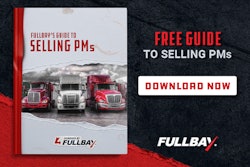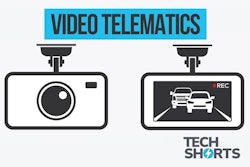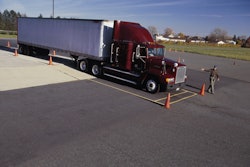The 2025 CVSA North American Roadcheck inspection spree is May 13-15. Inspectors will be on watch for various equipment and driver violations – like brake and tire wear issues, and hours of service – but hours-of-service (HOS) regulations and tires will get special focus this year.
While Roadcheck is a three-day enforcement campaign, Commercial Vehicle Safety Alliance's (CVSA) Roadside Inspection Specialist Jeremy Disbrow emphasised there's really nothing unique about the inspections themselves.
"The inspectors are doing the same North American Standard Level 1 Inspection that they always do. It includes the same 37-step procedures, so there's nothing really different in there, and it's done in all jurisdictions," he said. "Really, the only difference is that this is an all-hands-on-deck campaign, and there's a lot of partnership with enforcement that's involved here, and industry, to again, promote outreach and educational opportunities. But really, the inspection process is the same.
Below is a Q&A with Disbrow who tackles some common questions about how to have a successful and uneventful Roadcheck week.
Tires
CCJ: When do tires become out-of-service for rock drilling?
Disbrow: That's not an out-of-service violation. So the only debris, or rocks, or anything that would cause it to be put out-of-service are if they're wedged in between a set of duals. So if you have a rock that's wedged in between the dual set, that is an out-of-service defect; it has been for quite a few years. But just rocks that are jammed down into the tread, that is not... in fact, I'll take it a step further, even if you have a nail jammed down into the tread, as long as it's not leaking air, it's not a violation or an out-of-service violation. So that's a new one to me. But I can tell you it's not out-of-service, based on what you just described (rocks in the tread that do not cause a leak).
CCJ: What feedback have you had on the new tire inspection guidelines regarding automatic tire inflation systems?
Disbrow: I don't really have any feedback to report, but I can tell you that the out-of-service criteria supports the use of automatic tire inflation systems, or what we refer to as ATIS. So if there's an audible air leak in a tire and it doesn't have ATIS, it's automatically going to be placed out-of-service, because that becomes an imminent hazard and it's likely to cause a collision. So it's in the out-of-service criteria. But for tires that are equipped with ATIS, and that ATIS system can maintain the tire pressure during the inspection, it would only be considered a violation, they wouldn't be placed out-of-service. So while a leak is always going to be a violation, ATIS can make a world of difference between being shut down on the side of the road, versus being able to continue to a nearby shop and get the tire repaired.
CCJ: Are all CVSA officers trained aware of the new April 2024 out-of-service criteria in regard to tire inflation and air balance systems?
Disbrow: I hope so. We've done a heck of a job trying to get that word out. We've done live webinars, we've done recorded webinars, we've asked every inspector to do it, and every state that I know of has covered that in their in-service training. So the word is definitely out there. I can't guarantee it's reached every single person, but we've done a heck of a job trying to get the word out.
CCJ: What are inspectors looking for with tractor protection controls?
Disbrow: The most important safety aspect to look at is to ensure that the wheels on the drive axle are chocked. And an inspector is going to do that, but if any drivers are trying to do this test on their own, it's really important to make sure the wheels are chocked to prevent any injury or any accidents. But after that, they're going to ask the driver to release the brakes on the vehicle. They're going to ask the driver to remove the gladhands on the trailer, and it's going to allow all the air to deplete. As that air depletes, it should stop losing air before it reaches 20 PSI, and that's really just to ensure that there's enough air pressure in there to safely have a brake application. They're going to ask the driver after that to step on the brake pedal and make sure that no air escapes out of those air lines.
And then after that, they're going to check on the trailer side for any bleed back or any loss of air coming out of the trailer side of the gladhands. I know that's a quick way to go through those steps, and if anybody missed it, they can go to our website at CVSA.org, and there's actually some handouts that explain that process and that procedure, if you want to go through it with your drivers.
Lights
Every year, year after year, it seems like lights are right at the top of the out of service violations list.
"It's the low-hanging fruit," Disbrow said. "It's the stuff that should be caught on a pre-trip inspection, usually. I understand a light can go out in transit, but more often than not, it was probably out when you left. So just getting out of the truck, doing a walk around, and taking care of those obvious items like lights, tires, things like that, those are always right at the top of the list. I think in 2023, our number one violation somewhere around the 300,000 violation mark nationwide, not just at Roadcheck, but for the year, was lighting devices. So that's definitely a very common one."
"Obviously, (all lights are) important; all the required lights are important, but definitely, the rear facing lights on the rear most vehicle are the ones that are going to put you out-of-service for sure. So brake lights, turn signals, those are going to put you out-of-service on the rear. And then headlights, of course. If those aren't working, that'll put you out-of-service, too."
CCJ: So what are some common roadside inspection triggers?
Disbrow: It's the lack of the light, I think, a lot of the time that you're talking about. So again, it's that low-hanging fruit. So if you're a trooper and you're sitting in the median watching traffic go by at 65 miles an hour. What are you going to be able to see at that speed? And it's the obvious stuff, right? So, lighting that's out is always a real good flashing red light. It pulls your attention. Cargo securement is another one of those that you can definitely see, they're very obvious. So those are things you can expect to get pulled in for. Any other obvious defects like that are going to stand out to an inspector.
CCJ: Would it make sense for CVSA to put out some guidance on LED lights and the percent of diodes that can be inoperable?
Disbrow: The short answer is yes. The long answer is CVSA, FMCSA, NHTSA and a bunch of industry groups are basically coming together right now, it's ongoing, trying to determine what that threshold is, how many diodes can be burnt out before it comes a safety issue, things like that. So when it's determined, absolutely, we'll put that out to industry and enforcement. No question on that. For the time being, I'll tell you that the only thing that is enforceable, and this is what has been given out to inspectors, is ensuring that the LED lights, whether there's one or 10 that are working, are visible from the required minimum distance under state and federal law. So I'm not talking a number of diodes, I'm talking about the visibility of those diodes. That's really the only thing we can enforce. That being said, though, I do want to preface this, and I try to tell everybody this, if I were a carrier, I'd replace them before they get that severe.
And simply, from a liability and a safety standpoint, lights are extremely important for safety, they absolutely can cause collisions, especially the rear-facing lights, if a driver doesn't see them and goes underneath the vehicle. And quite frankly, the cost of replacing that light is a heck of a lot cheaper than what you're going to face in civil liability later after a collision. So this is just my opinion, but to me, a defense is not going to hold up in court if you say, "Well, I still had two diodes working out of 20." That's not going to get you anywhere in a civil lawsuit. So just from that standpoint, I suggest being cautious and errant on the side of safety. But the short answer is, yes, we will put that information out, but we are still trying to make sure we have a good answer. We don't want to throw something out there that necessarily doesn't reflect safety. We can't say 50% if, really, 25% of them are okay. So we don't want to jump the gun, we want to make sure we have a good answer before we put that guidance out.
CCJ: Do additional lights, like chicken lights, need to be illuminated or just the required lights listed in the reg book?
You can put 400 extra lights on that truck, and they don't have to work. The only ones that have to work are the required lights listed in the table in 393.11.
Drivers
A good way for driver's to prepare is to have paperwork together and have it ready.
"It shows that you're a prepared driver, you're a professional driver, and you know where to find everything. If you carry your papers in an electronic format, like in a PDF, download them ahead of time," Disbrow said. "When you start your trip, it's very helpful to have any electronic documents already saved at your device, because if you get pulled over in an area where there's no internet connection, you're going to have a difficult time trying to show that to the inspector, and it's just going to amp up your nerves a little bit more. So being prepared, I think, is huge. ELDs, they're not new anymore, but there's still a lot of drivers out there that don't know how to manipulate everything in their ELD, they don't necessarily know how to transfer records. So read those instruction manuals, get familiar with how you're supposed to transmit those because it's really a driver responsibility. I know a lot of inspectors will help a driver out sometimes and show them how to do it, but really, that's the driver's responsibility, and it can calm your nerves a lot if you're able to navigate it and do what you need to do. So those are all ways to reduce stress, show that inspector that you're a professional driver, and you're doing what's right."
CCJ: Do drivers need to carry their medical certificate?
So according to the federal regulations right now, you're just required to carry it for 15 days after you receive it. That's going to go away next year. But right now, the short answer is you got to carry it for 15 days after you get your medical card. That said, I always encourage drivers to carry their card on them just in case there's a discrepancy between the state driver's licensing agency and what's displayed on your card. So it may result in a violation either way, unless you can resolve it, but it may prevent you from being placed out-of-service if you have it in your possession. So an example, and I've seen this before, is where a driver has a valid medical certificate in their possession. They show it to the inspector, but the inspector goes back to the program, they check, which is called SID list, or they could also check their state database, and they see a note that says, "No medical card on file." So if you're just using that database, it's going to look like there's no medical card.
Is it still a violation? Yeah, it is, and you can DataQ it later or whatever. But the difference is, if you can show that card in your possession, it's not going to put you out-of-service, which means you're not going to be stuck in the middle of wherever you're at, you can continue your trip. So that's a big deal. So it doesn't cost you anything to carry it, it's helpful to have it. So I would recommend keeping it on file. The only exception to that real quick is some states will automatically suspend your driver's license if they don't have a copy of your medical card on file. So that's a whole separate issue, because now, it's not necessarily a medical card issue, it's now a suspended driver's license.
And in those cases, an inspector really has no leeway. If the state is saying that you're suspended, it ties the inspector's hands at that point, kind of, and they have to put you out-of-service for the suspended license. So it may not save you from that, it just depends on how it's entered into the database. But again, no harm in carrying it, and it can only benefit you by carrying it. So I would keep it on me.
CCJ: What, if any, document is asked from a driver that's using a short-haul exemption?
None, when it comes to log books. So if you're actively working under the short-haul provision, or what's commonly referred to as the local exemption, you're not required to provide a log book during a roadside inspection. Some inspectors might ask for it, but the short answer is, in 395.1 question, I think it's interpretation question 13, it says, "You don't have to carry any log book as long as you're following the guidelines of the short-haul provision." Again, I never give a short answer, so I'll tell you there's a caveat to that, and it throws a lot of drivers off. A lot of people think if they're within the 150-air-mile radius, that's the only requirement. That is not the case. So in order to use the short-haul provision, the driver still has to have a timekeeping system that they're using, it doesn't need to be a log book, but it could be a time card at the office, or the manager's, or somebody could jot down their start and stop time every day, but they got to have some recording system in place.
They have to have 10 hours of rest before they come on duty... or off duty period before they come on duty, and they have to return back to their work reporting location within 14 hours of coming on duty. If they don't meet all those requirements, then they cannot use the short-haul provision for that day, and they have to have a log book, or an ELD, or whatever. So the short answer is nothing, you don't have to have anything as long as you're following the exemption to a tee. But if you're not, then you got to have a log book.
CCJ: What's a good remedial or refresher resource for hours of service training?
So I guess it depends on if we're talking about ELDs. The first thing, like I mentioned earlier, is just being familiar with your device and going through the instruction manual, making sure you know how to transmit, and all that kind of stuff. If you're talking about the actual hours of service rules, I can't recommend a company, I'm not really allowed to recommend a company, but I can tell you there's a lot of online companies out there that do some types of refresher training. I am going to recommend one company, and that's a non-profit called CVSA, because we do offer a 40-hour in-person course that is very similar to what a roadside inspector takes to get certified.
So if you want to learn the ins and outs of hours of service, from top to bottom, and you want to learn all the CDL requirements and all those requirements, CVSA does offer a course. We do that frequently, and if you go to our website at cvsa.org, you can see a list of the classes that are coming up. But there are plenty of other places that do it too, they do online training and stuff like that.
CCJ: Can you give a clear and concise instruction on the proper use of personal conveyance?
personal conveyance can be confusing for drivers and inspectors, and me, and everybody else. CVSA has petitioned FMCSA to try to put out some more clear guidance, because I think everybody here listening to this knows that it's difficult sometimes to know what's expected. For the time being, all we can really use at CVSA, or you as a driver, or you as a motor carrier, is to go back to the FMCSA's website and read the interpretation questions, and read the FAQs, because that'll clear up probably 99% of the issues. It can't cover everything, and I could spend hours talking about all the what-ifs that could come up. But quite frankly, there's just a few things I want to hit real fast. Number one, if you go to the FAQs, it'll give you a list, and it'll tell you what the proper uses are and what some of the improper uses are.
So if you're familiar with that, I think it'll resolve quite a few of the questions out there. Some of the highlights though are, number one, you can't be doing any business at the time for the motor carrier. So you have to be off-duty, you have to be relieved of all responsibility, and you have to be at liberty to do what you choose to do during that time period. That's the definition of off-duty. So you got to be off-duty. And then it goes on to list proper uses and improper uses. So some of the common proper uses would just be things like going to get food. So you get hungry in the middle of the rest area, you decide at 2:00 in the morning you want to go to McDonald's, that's absolutely what PC is for. Going to lodging, or going to do some entertainment, going to watch a movie, the casino, whatever the case is, that's what personal conveyance is for.
Where it falls apart for drivers a lot of the time is an improper use, is you cannot enhance the operational readiness of the motor carrier. And that basically is just saying it cannot be used to get closer to a pickup, or a drop-off location, or anything else that would further the load. And this one causes a lot of problems for drivers, and a lot of it just comes down to common sense as to whether you're enhancing the operational readiness or not. And let me give you an example. If a driver goes five miles to a nearby restaurant to get food, then that restaurant just happens to be in the same direction as the drop-off location, I think any inspector will use reasonable judgment and say, "That's fine." On the other hand though, what commonly happens is a driver may pass 25 restaurants, or 50 restaurants, and they go another 100 miles in the direction of the load.
That's where it's going to be pretty hard to convince an inspector that you're not enhancing the operational readiness. So that would be considered probably an improper use. A couple other things that I see get hung up with drivers a lot of the time is PC can't be used to extend your duty day. It can't extend the 11 to 14 or the 60 or 70 hour rule, and that's clearly written out in the FAQs. So that's likely going to result in a violation or a misuse of PC if that's what you're doing. I've seen drivers frequently, you'll see it in their logbook every day, at 10 hours and 55 minutes of driving, all of a sudden, they switch over to PC and they may drive another hour or two hours every day. And that's not what it's for, it's not designed to just give you an extra bonus of two hours of driving time. So just be careful with that. And those are going to stand out to inspectors.
And the one other thing I see is it can't be used to further anything for the motor carrier. So in other words, I've seen it frequently where the driver will use it and they'll put a note in there saying that they were taken the vehicle to go get repaired. Well, getting the vehicle repaired is an on-duty function in and of itself. So that can't be used under personal conveyance time, and it's laid out in those FAQs as well. So getting fuel, going to a repair facility, things like that, are definitely going to be considered a misuse of personal conveyance. One last thing though is, like I said, for the short time that we have together, I can't hit everything, but go to the FAQ page on FMCSA's website, and give it a look if you haven't done it, and hopefully, that'll clear up some of those answers.
CCJ: Do employees like mechanics testing a truck and salespeople delivering a vehicle need a CDL?
Yep. So there's actually an interpretation in the regulations. It's 383.1 interpretation question 2, I think, if I remember right. But that specific question is asked, "Do mechanics, and shop help, and other people like that need to have a CDL?" And the answer is absolutely yes.
CCJ: Is there a way for a person in an administrative role to keep their CDL without being required to get a DOT physical until they want to drive again?
No. In the past you probably could have; back in a few years ago. Now, CDLs are tied to medical cards. The medical card will automatically disqualify your CDL if you don't have it. So you have to submit a valid medical card, and let's say your card is good for two years, you're going to have to update it every two years with the driver's licensing agency, or they're basically going to disqualify you from operating a commercial vehicle.
CCJ: How will inspectors conduct an inspection for controlled substance possession?
Disbrow: So inspectors are asked to do the same inspection that they always do, but they're just asking to have a heightened awareness, I guess, for what they're always looking for anyway, and that's indicators of impaired drivers. So they're going to be looking for signs and symptoms of impairment, just like they always do while they're talking to the driver. It's nothing different, they do that all the time, whether you realize it or not. While they're doing that, they're also looking for drugs and alcohol that are sitting there in plain view anywhere inside the cab. That's a great opportunity to see what's going on inside the truck. So it's more of a hypervigilance thing, but it's not really anything different, it's what they're always looking for.
But one thing I do want to point out, it's important to note that right now, a large portion of the focus is in the United States, on the Drug & Alcohol Clearinghouse. And in every inspection, inspectors are asked to query the Drug & Alcohol Clearinghouse and just make sure that drivers aren't prohibited in there. And we're also just reminding motor carriers to be checking their drivers periodically to make sure that there's no prohibitions and they're not putting somebody behind the wheel that they shouldn't be.
CCJ: What are the legalities of drugs and alcohol in the cab?
Disbrow: Right now, marijuana is still a Schedule 1 substance, in the United States at least, and it's strictly prohibited in a commercial vehicle, and the use of it is prohibited as well, regardless of the state you're in and what their laws are. It's also important to know that even in states where marijuana is legal, drivers are still subject to a DOT drug test, and they still look for the same things, which include THC. So it's unfortunate, but I think a lot of drivers believe that it's legal in their state, so maybe on the weekend, they go out and use a little bit of marijuana, or they go to a party and use it thinking they're off duty and they'll sleep it off or whatever. But then they come back to work, they have a subsequent drug test for some reason, and they end up failing that test, which ultimately is going to end up costing them their CDL, they'll end up prohibited in the clearinghouse.
[Alcohol regulations] can vary between the U.S. and Canada, but let me hit the U.S. first. In the U.S., it's pretty clear-cut: alcohol is prohibited in any commercial vehicle while the driver's on duty, according to the federal regulations. This includes anywhere inside the vehicle, whether it's the cab or the trailer. The only exception to that really is if it's manifested as part of the load. The requirement applies to unopened and opened bottles of alcohol. So, as a rule of thumb, it doesn't belong in the vehicle anywhere. In Canada... the requirements can vary by each province, from what I'm being told and to the best of my knowledge. But I can tell you, even in Canada, it's definitely prohibited in every province that I'm aware of to be within the reach of the driver. But again, to play it safe, really, it's not wise to have it in the vehicle at all, especially when you're on duty.
CCJ: What about prescription medication?
Disbrow: So a lot of people don't necessarily carry their medications in a prescription bottle. A lot of people use a weekly pill container, or whatever, to sort their medications, and that's fine. In general, you're welcome to carry your medications in a pill container. That being said, though, it's just important to remember that narcotics, amphetamines, certain Schedule 1 drugs and things like that are not allowed in a commercial vehicle. And certain habit-forming drugs can also potentially cause impairment, so those need to be accompanied by a letter from your doctor, or something that says it's not going to impair your ability to safely operate a commercial vehicle. That's one of the requirements. So if you're in doubt and you're not sure if it's one of those types of medications, I would definitely carry the prescription bottle just to show that it belongs to you. But if you're talking just general prescriptions, migraine medicine, things like that, you absolutely can keep those in other pill containers, and things like that.
CCJ: Would a driver be put OOS if the inspector finds that no Clearinghouse query was made by the driver's current company?
Disbrow: Yes. So the regulations say that a driver can't operate a commercial vehicle if they're in a prohibited status in the Drug & Alcohol Clearinghouse, and that's regardless of whether the carrier checked their status or not, even if they're unaware of it. On the flip side, carriers are required to do that as well. So if a carrier's not checking them like they should be, that's something that would probably be handled in a subsequent investigation or something like that.
CCJ: Are inspectors going to run a Clearinghouse query on all of the drivers inspected during the campaign?
Disbrow: Yeah, they're supposed to. It is a fairly new database out there, and inspectors have a lot of databases to check while they're doing this. So we're trying to raise awareness both for the inspectors and the industry side, and we are definitely asking them to do it every time.













